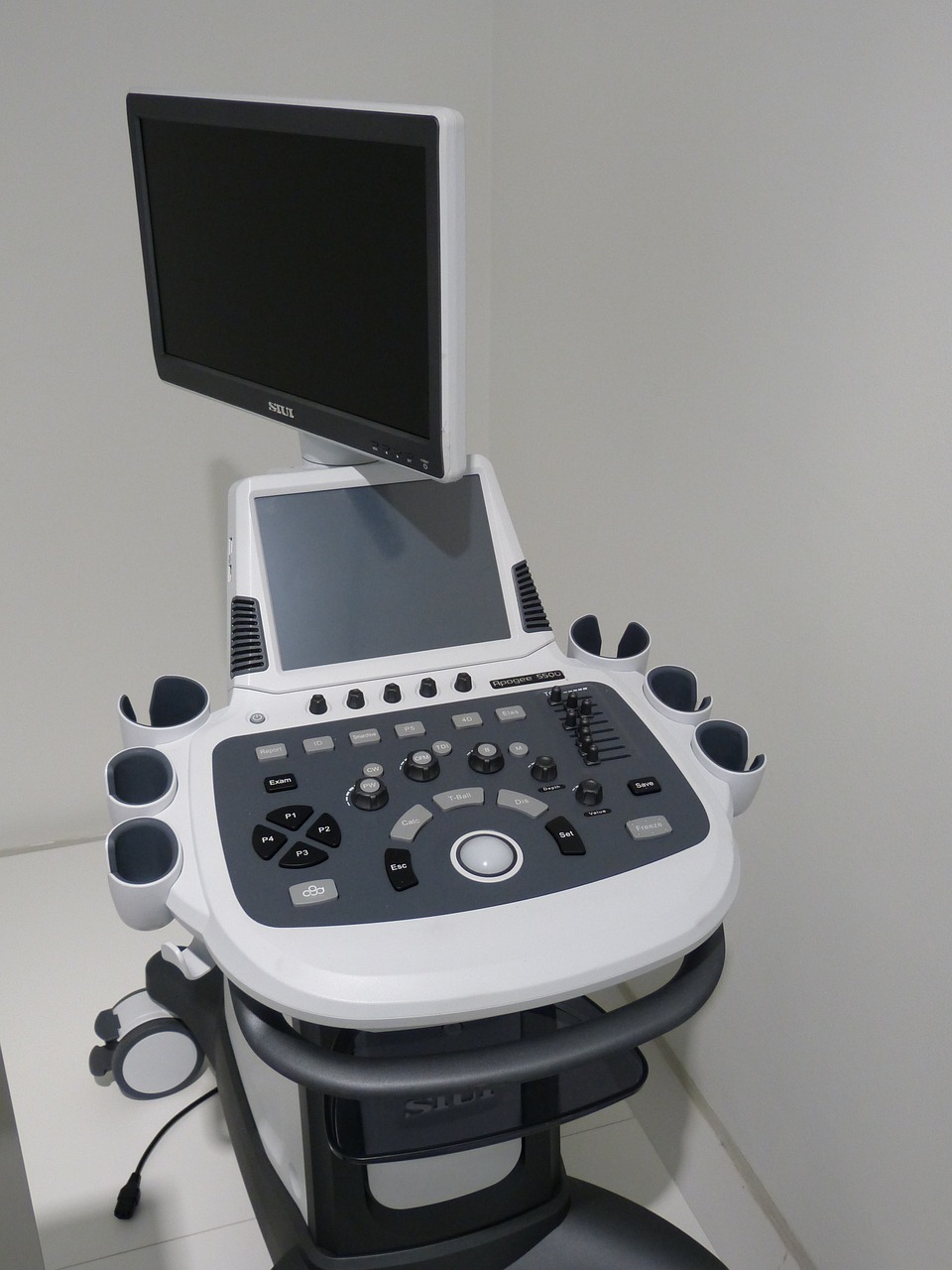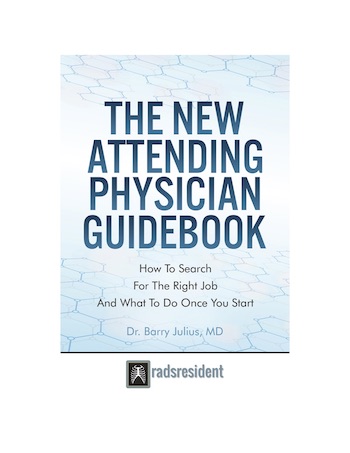
Question:
Hi! I was wondering what source you would recommend as the best to teach ultrasound to radiology residents?
Thank you!!

Hi! I was wondering what source you would recommend as the best to teach ultrasound to radiology residents?
Thank you!!

Did you ever wonder how your radiology program director started to run a radiology residency? Did she desire this calling from day one or did the residency bestow this honor upon her? Well, let me tell you a little about the world of residency directors (my world!)
Typically, let me give you a picture of the process. It usually happens like this. The Chairman of the radiology department comments at a meeting, “Who wants to take on the role of the new residency director?” You hear a wall of silence. Then, the Chairman asks, “Who doesn’t want the role of radiology program director?” And, then everyone raises their hand except the one guy who is sleeping in the corner. So, who do you think gets this vaunted position?
All kidding aside (not really!), it does take a unique (better phrased “atypically crazy”) individual to relish the opportunity to become a program director. Today, I am going to go into the type of person that can succeed and can find this role rewarding. Moreover, I will talk about the most significant challenges and rewards of this position.
Not all personalities can handle the position of the radiology program director. If you have anger management issues or react before thinking, you are in for a lot of trouble. Optimally, you want to install a person who has a lot of patience, enjoys teaching residents, and can handle long hours of paperwork. But, unfortunately, many times, that is not the case. Hence, the enormous turnover in residency directors. The turnover in residency directors occurs over six years on average, more rapidly than most other residency programs. (check out this article from 2013 by Dr. Ruchman on AJR)
Most importantly, however, this individual needs to understand the dynamics of working with other people. My theory about why the turnover is so high for radiology program directors: I believe that departments select program directors based on academic credentials and technical skills, not upon the personality that will be running these programs (A big mistake!) You cannot expect to run a program well without excellent communication skills. Believe me. Nothing angers residents more than working with a program director that does not listen and talk to the residents within their program!
When I started writing this paragraph, I could not even think about where to begin since the trials and tribulations have been so numerous. But, I will take a stab at some of the more significant ones.
As much as any program director would like to say he picks the perfect residents and never had any issues during their tenure, this is rarely the case. (This is also true at the most “prestigious” programs- but they will not let that on!) To this point, most program directors have incredible stories of resident hardships, horrifying incidents, and more. All you have to do is ask, and they will tell you a bizarre story or two! But, here are some of the most difficult of the challenges.
The biggest challenge to the average program director is the struggling resident that cannot make it through the program. And, this may be for any number of reasons, but most commonly related to mental health, learning disability, or social/professionalism issues. Fortunately, these encounters are rare. And, most of the time, the residency team can solve them. But, every once in a while, they do crop up, and residency programs will have to let a resident go.
Trust me. It is heart-wrenching and terrible. However, in the end, each residency director has to attest to the following when they sign the graduation certificate, “This resident is competent to practice in the field of radiology.” And, if you cannot do that, then you cannot graduate the resident. We have a responsibility to the community to make sure that dangerous radiologists do not practice medicine. If you are working as a director long enough, it will happen in your program.
Also, of course, there are the “one-off” incidents that most directors will encounter that can present real challenges as well. What do I mean by that? You have a resident that gets into trouble with the law for a DUI or a fist fight between a radiology resident and a surgeon in the middle of the night. I can tell you that each situation is unique and presents its own set of challenges on how to deal with them. We are always flying by the seat of our pants!
Lastly, we need to accept the responsibility of mind-numbing paperwork at times. In the past, with the old site visit system, we needed to create a gazillion essays about why our residency program should exist with terminology and mumbo-jumbo that you would not believe based on the musings of a few Ph.D. education types. But even today, with the newer site visit system, we still have enormous quantities of documentation to prepare.
Additionally, between the milestones, surveys, resident/faculty evaluations, meeting minutes, and more, you need an army of coordinators and personnel who are computer savvy to make sure your residency program can continue to survive. (That’s why small residency programs find it challenging to survive) However, many of these responsibilities often fall into the lap of the program director. And, these items are just the proverbial tip of the iceberg!
Yes, with great responsibility comes great rewards. And, this time-honored cliche applies no differently to those running a radiology residency program. I can think of almost no better feeling than to see your residents succeed, becoming chairmen of other departments, writing inciteful academic papers, and becoming incredible clinicians once they graduate.
Also, getting your residents past the hardships they may encounter during their residency program can take an incredible amount of work, but there is no better reward than getting them over these obstacles and watching them take off in their careers. In the end, we are coaches and mentors. And, if you like these roles, you may enjoy becoming a program director (As long as you can accept all the other flaws that go with it!)
Well, after all this discussion, the short answer is yes, we are nuts. We need to have unique nutty characteristics that enable us to succeed in our job. And, we take joy in the experience of teaching over all the other issues that come with the position. But, if that is nuts, so be it!

Dear Dr. Julius,
Here I am again, this question may not fall under ‘ask the residency director‘ category, but it can fall under ‘ask the radiology director who aims to spread knowledge about everything related to radiology.’
So my question is, what would be the best radiology blogs you can recommend? In your blog, I saw your posts about social media, and from time to time you mention other good bloggers such as Eric Postal, etc. but I believe we can highly benefit from a list of recommendations processed by you and your years of experience in this field. Addition to that apart from blogs, what other websites/MOOCs can you recommend for learning Radiology?
Thanks in advance.

Hi Dr. Julius,
I have a few questions for you about pregnancy during radiology residency that I wanted to know.
Is pregnancy in radiology residency doable?
Are programs supportive of students who expand their family during residency?
Are there radiation exposures that I would need to avoid in a diagnostic radiology residency?
Is there a typical year of residency easier to have a baby than others?
With radiology being a male-dominated specialty does this cause strife between residents during maternity leave? (Is there maternity leave?)
How do you decide if a program is family friendly and future-family friendly?
Thank you!
Sincerely,
Future radiologist
———————————
Hi future radiologist,
I have to say I have been getting some great questions from my audience and yours is no exception!
So, let’s start from the beginning… Is radiology residency doable for a pregnant resident? My quick answer is undoubtedly yes. Many have done it before.
But, let me give you a bit of the more detailed response to your inquiry. It’s not whether it’s doable, the question is, do you want to do it at this point in your life? By no means is it a cake walk.
So, what changes? Typically, many pregnant residents will lay off the fluoroscopy and the interventions that involve ionizing radiation. And, depending on how your pregnancy goes, you may feel tired and nauseous at times. But, most get through the residency just fine.
And, of course, you are entitled to pregnancy leave which I believe is usually three months. Depending on how much time off you take, that may extend your residency a few months. Moreover, the additional time can delay the timing of your fellowship.
Then, finally, you will probably need some help with the kids once you do restart your residency after the pregnancy.
Comparing radiology to other residencies, I believe it is more doable than some and harder than others. Those long nights with a reversal of sleep schedule can be tough on typical residents let alone pregnant ones. The hospital will constantly bombard you with images with no time to sleep. Psychiatry and derm are some specialties that don’t have those tough calls. But then again you are practicing psychiatry and derm, not where I would want to be!
And, perhaps it is not as grueling as surgery. But, it all depends on what you want.
If I had to choose within the current system, I would have to say in most programs the 4th year (after you have passed your boards) would be the best time. It is the least demanding in most residencies (but not all!) Usually, you can fill it with mini-fellowships, electives, and less call shifts than other years (although some have 4th-year weighted call).
I will say the following; Whenever you have one person with different sets of requirements from the others, you will have some resentment. Call shifts will increase for your classmates in spurts. You will have to give them back afterward, so it eventually evens out.
But, in the end, this is a personal decision to make and regardless of what others think it is probably not best to put it off too long because of the increased risks of waiting too long.
So, if I were looking for a residency for my wife where she would have the best situation while pregnant, I would say, most critically, pick one near family members that can help out. Next, I would want to find one where the call might be a little bit lighter. Or, one that has a decent 4th year if that is when you want it. And finally, find a program director that you believe will be able to commiserate with and support you during residency.
I hope this answers some of your questions!
Barry Julius, MD
Do you believe in the common cliché, “A picture is worth a thousand words?” And, are you interested in how to apply it to the interview process? Then, take a look at the recent paper in Academic Medicine entitled The Ethical and Legal Conundrum Posed by Requesting Residency Applicants to Submit Photographs of Themselves, and the Medscape article of an interview with the same author of this study in an article called Are Residency Application Photos Used for Discrimination? Both pieces made lots of interesting points about the use of photographs for interviewing residents. However, I found the discussion in both of these articles to be a bit unsettling. And, let me show you why.
Well, take a look at the following quote as one of the final statements in the interview as a summary for the articles, “The photograph does not provide useful information that is necessary for selecting qualified candidates. Unless there’s a compelling argument for why you need a photograph, which so far no one has brought to me, I think it is unnecessary. Everyone I’ve shown the article to has agreed with our point of view. I am concerned that this is a possibly illegal practice, that it can cause people to be discriminated against, and that it is unfair.”
Let’s step back for a moment and think about this statement. At first glance, I initially agreed with the concept behind the article. Programs should never use a photograph to prescreen candidates. For instance, let’s say that one of the screeners in a program happened to hate nose rings. And, the image of an applicant showed her wearing a nose ring. Then, we might have excluded this applicant from the interview pool not based on credentials, but rather a nose ring on a photograph. It could theoretically work that same way for race or ethnicity. That should never happen. I get it.
But, let’s take it to the next level. Once applicants have made it through the prescreening process and have arrived at our site for an interview, pictures can be beneficial to the applicant and the process. We’ve already seen the candidate. And, every time I look at a picture of the applicant, it jogs my memory about the person, the conversation, and the time. Often, the picture saves the day since so many interviews on a busy day can blur the lines between the candidates. Why would you want to get rid of such a tool?
Furthermore, we all have eyes and faces. You can’t ask all applicants to wear masks to an interview. Likewise, you cannot blindfold all the interviewers. And, if the picture is not biased enough, what about our voices? I mean everyone has a distinct accent. Uh oh, now applicants must wear sound mufflers to make sure that we cannot determine their identities. And, what about our clothes? Our clothes can give away our culture and attitudes. Why don’t we have all applicants arrive at our interviews wearing the same required outfit? I think you get the point, but you can take anti-bias precautions to an extreme that no longer makes sense. And, that’s where both of these articles went.
Applicant photographs do not belong in the prescreening process. We should choose who we interview based on merit alone. Perhaps, we should look at these pictures only after we have selected the candidate for an interview.
However, I believe these papers over-sanitize the interviewing process and residency program use of photographs. We are not perfect in making decisions about our candidates. And, we all have our innate biases. But, we should not erase the interview pictures from the applicant’s record just because it may affect our judgment. We need our judgment to decide who we should choose for our programs. Let’s not take this anti-bias point too far!
For years and years, programs throughout the country have been utilizing the ACR in-service exam as a way to find out if residents have been keeping up with the material. And, from my experience, the correlation of the test with the Dow Jones Industrial Average on any given day is higher than that measure. And, many program directors believe the same. Now, for the past year or so, programs throughout the country have been utilizing the new Radexam to drill down on radiology topics to check the same measures. But, is this exam all that it cracked up to be and what do we know about it? What would be the optimal exam if I had my druthers? Should we be using any monthly or annual review to test residents at all? Or, perhaps, we should eventually overhaul the current core exam process in favor of Radexam-like alternative?
Unlike the previous in-service examination, the ACR created Radexam as a crowdsourced evaluation tool. Academic radiologists are constantly vetting the questions. Also, dissimilar to the in-service, the exam evaluates the resident based on her specific rotation. You will be able to tailor particular question banks to your individualized monthly requirements at your institution, whether modality or topic based. If you have a cardiovascular MR rotation, theoretically, you can create an exam that tests on that rotation. And finally, you can evaluate residents with this tool on a monthly basis.
After I have seen an exam from the batch, the test looks hopeful as a tool for making sure that residents are keeping up with the material. But, the only way to know for sure is to correlate the test with resident evaluations and the core examination. That should be coming to a theater near you soon!
OK. Deciding upon the optimal exam is a tough one. But, let’s give it a whirl. Well, first and foremost, we have to remember the purpose of an examination for residency. And, no the target of an exam is not to correlate with board passage rates. Instead, we should be thinking farther down the road. Is the test evaluating residents on the skills that they will need to become a good radiologist? Test authors often get hung up on creating an exam for the exam’s sake and forget about this end purpose. If I were a test creator, I would have none of that.
What else? Well, I would create an examination such that if you were able to pass it, you could demonstrate to your government, colleagues, and patients that you have the necessary skills to practice radiology. Forget about curves and complicated statistical mumbo-jumbo. I would not care if the pass rate was 87 percent, 100 percent, or 2 percent. All I care about is that our residents have the abilities and skills that they need to practice. In the end, that is all the public should care about too.
Additionally, it would not happen at one sitting. No more travel to Chicago, Tuscon, etc. Instead, you would take it continually throughout your residency at your program as a way to show you have gradually mastered the competencies that you need to practice.
Finally, the exam should be relatively reasonably priced on resident budgets so that they can afford the fees to create it. Theoretically, this is a tough one, I know. But, with large amounts of student debt racked up over medical school and residency, it cannot be more critical.
Well, this is the million dollar question that residency directors throughout the country are trying to answer. The success or failure of this exam hinges on this answer. Unfortunately, we don’t know the answer to this right now. But, I suspect that the correlation will be higher than the previous in-service exam. It does not take much. So, in that respect, you would be able to call it a success.
The more often that we evaluate a resident during residency, the more likely that we can closely follow the learning process. On the downside, however, no one likes to be placed underneath a microscope at all times. Additionally, testing creates an artificial environment that differs from the day-to-day practice of radiology and medicine in general. But overall, the more often you test, the better you can check to see if the resident is completing the learning tasks necessary to become a radiologist. And, that brings me to my next and final thought.
If the core exam, as we know it, does not satisfy many of the criteria for an optimal examination, should we consider looking for alternatives? I believe that the curt answer is yes. And, Radexam may fit the bill if we drill down on it a bit.
First of all, it tests residents more often than a core exam, so that it allows a more accurate evaluation of the resident’s medical knowledge and skills throughout residency. Second, you can have residents take it on a home computer in a more realistic setting instead of some impersonal test center of some sort, leading to test-taking anxieties. Third, Radexam is crowdsourced and overhauled continuously throughout the year. Instead, the core exam questions are vetted, but only at a few intervals. And, finally, you can attune the Radexam to your program. Not all programs teach the same material throughout the country. Moreover, not all the content on the core exam will be relevant to your future practice of radiology. Radexam may resolve that issue.
We are still not quite there yet when it comes to knowing about exactly how Radexam will play out. In any case, I am hopeful that the outcomes will match up with the medical knowledge and skills that residents need to learn. And, as a bonus, I also would like to see a better correlation of Radexam with the core exam outcomes. (which I think we will) If these correlations are high, perhaps, we should consider Radexam as an alternative to entirely replace the in-service that we use right now and maybe sometime down the road, the core exam. Although no test is perfect, many of its features are significantly closer to my optimal examination than the current ones. Let’s start the debate to consider our best options.
Hello Dr. Barry Julius,
I am a 4th-year osteopathic medical student that is struggling to figure out how I can pull off getting into a radiology residency with disappointing COMLEX scores and a completely sub-par application.
I finally realized what I wanted to do in medicine and now I fear it’s too late. I come from a surgical background having been a Certified Surgical Technologist and First Assistant for ten years before getting to medical school. I realized during my 3rd year that I didn’t want to be a surgeon.
I fell in love with radiology during my ER rotation this year. I loved feeling like I was finally helping patients by reading films. So many times, I felt like I never got to the root of a patient’s problems in internal medicine and family medicine but with radiology, I felt like I was solving a problem. As soon as the radiology bug bit me, I immediately started researching requirements for getting into a diagnostic radiology residency. This task broke my heart into a million pieces. All I found was how competitive the programs were and how essential board scores were.
Passing COMLEX level 1 was the hardest thing I’ve had to do in medical school. I failed twice and finally barely passed on my 3rd attempt. I’m both ashamed and proud of how many times took the exam. I’m proud because I never considered quitting. Medicine has always been my passion, and nothing would ever make me give up on the dream of becoming a physician. I never felt like COMLEX was ultimately going to defeat me.
I’m also proud because I learned a lot about how to study and how I learn best. I’m ashamed because it made me feel like I wouldn’t make a great physician. Many mentors and patients have told me that I would make a fantastic physician. In my heart I know I would.
I made friends with the radiologist at the hospital where I did my ER rotation, and I’m doing an elective rotation with him starting next week. I’m really excited about this opportunity but lingering in the back of my mind is maybe I have no chance of getting into a radiology residency. Tons of people have told me there is no way to salvage my situation, but I can’t accept that. I’m a fighter and always have been.
Even if you never reply to this message I honestly appreciate the chance to vent. The bottom line is, I will never give up trying to achieve what I want especially now that I’m so passionate about it. After reading some of your posts, I just wanted to know what you would do in my situation. What is your advice for someone like me, with a worthless application, but a strong drive to do whatever is necessary to achieve a goal?
Regards,
Worried Radiology Applicant
Sorry, I have been unable to get back to you sooner. It has been a crazy week. However, I have had some time to mull the issues that you present in the letter and I have come up with a potential solution. But, it will take some soul searching, grit, and determination.
Why are the medical school exam board exams so critical for radiology residencies? Simply because the radiology boards is also a multiple choice question computer exam that is difficult to pass. And, most residencies would not want to commit resources to a resident that will not be able to pass the boards.
So, this is what do you need to do. First, you need to figure out why you have such a hard time with the exam. This may be the most difficult part for you, to admit there may be a psychological problem with test taking to begin with. Many times this is a simple issue that can be easily solved. They have testing psychologists that can get to the root cause. It would be well worth your time to splurge a few thousand dollars now to get the answer that may save you hardship down the road.
For some, the issue can be solved with something as simple as anxiety exercises before the test. For others, it could be a learning disability that you were not aware of. Regardless, make the time and effort to complete this step. It will be well worth it.
Second, you need to take the USMLE. The good news for you: Most radiology residencies do not like to use the COMLEX as a screening tool. So, if you were to do well on the USMLE, they would never even care about your score on the COMLEX.
So, finally, I would dedicate a year to studying for the USMLE exams and doing well on them. How would I approach it? I would take a year of research in radiology to stay involved in the field. And, I would study at the same time so that you can get the scores you need.
It will take a lot of from you to really tackle the issue of passing the USMLE and getting into radiology residency. But, if you really want it that bad, there is a way.

So, your residency director begins to talk about his most successful radiology residents over the past ten years. But what does that mean exactly? And do you want to be part of that list? Well, maybe or maybe not.
Most of the time, the resident’s and program director’s expectations align precisely. But other times, the definition of a successful resident from a residency director’s perspective may vary widely from yours. In this light, we will talk about the expectations of a residency director and your expectations of the meaning of a “successful” radiology resident. Moreover, we will look into those conflicts of interest that may arise between the two expectations.
So, what makes a residency director happy with his residents? Well, for many directors, it comes down to reducing the heavy workloads. And, to keep their work to a minimum, most residency directors want their residents to comply with the basic expectations of a radiology residency program during the four years. In other words, these are some of the phrases that a residency director would want to apply to their best residents.
1. Passes the core exam on the first try
2. Completes all the necessary work on his own
3. Doesn’t create too much noise during residency.
4. Is expeditious with his work
5. Gets along well with others
6. Completes fellowship after residency
7. Enters academics and has a radiology career
8. Creates his research projects independently
9. Continues to produce research independently after graduation
On the other hand, what does a resident think would make the best sort of resident during his training? Here are some short descriptive sentences.
1. Reads enough during residency to have a good background for his career
2. Experiences and learns about all the procedures and modalities in the field.
3. Gets along well with colleagues and attendings
4. Makes connections for fellowship and beyond
5. Does not get sued
6. Can find a quality job in a desirable location with reasonable income after his residency
The program gains more clout for a residency director when it produces large amounts of academics. For one, the Radiology Review Committee/ACGME will be much less likely to cite a residency if they have sent many abstracts to national conferences and have written numerous publications. On the other hand, many residents can care less about pursuing research and utilize it only as an avenue to graduate residency.
Often, residency directors like the status quo. To accomplish this, they would rather have their residents go through the motions of completing their work without changing the system. It becomes a less complex pathway with fewer chores to do. However, on some occasions, by not vocalizing educational issues, radiology residents may sacrifice their education and career. So, the resident may not find it appropriate to maintain silence.
Sometimes, the program director’s definition of an acceptable career choice differs widely from his radiology residents. For instance, she may expect residents to go on to academic or prestigious private practice careers to maintain the “lineage” of the program. Nevertheless, the best career pathway may not always apply to each resident who comes through the system. Some residents may have business interests or may not have the desire to enter a typical career.
For most residents, completing the radiology boards become a critical step to obtaining a desirable job. And it also adds to the positive statistics of a program. But sometimes, passing the big exam is unnecessary to get the career the radiology resident wants. Perhaps, they want to enter the business world. Or, they have a job lined up in some other area. Taking and passing a board may become less critical to this resident than the radiology program.
The program director’s and the radiology resident’s expectations of the “successful” resident usually align. However, occasionally they don’t match up. It’s like parenting. Sometimes, we need to let our residents take an untraversed pathway. We, as program directors, cannot always force our residents down the same well-trodden trails. And radiology residents should not expect that they always need to perform the desired requirements. Instead, radiology residency directors, residents, and the external regulating bodies should redefine their expectations for success with the understanding that “successful” residents do not always fit an identical mold.

As an associate program director, I work with all the residents and faculty. But, one role, in particular, plays an even more significant role in the quality of the residency than the others. Which one would that be? (Hint: Well, if you have not guessed it by now, you may want to look at the title again! The Chair)
OK. So, the chair is critical to running a great residency. But what is it about a chairperson that makes the role so important? Well, the importance of the position is what we will run through over the following, oh, say, 8oo or so words!
Everyone, once in a while, events conspire to mangle a residency program. Perhaps, a resident decides to leave for another career, and the hospital wants to take away the residency slot forever. Or, the emergency department determines they no longer want residents to give the final dictations at nighttime. In any of these cases, you need a firm chair to prevent these issues from negatively affecting the residency program. Sometimes you need a leader to fight for your department!
What would happen if you had a chair that decided to commit more resources to non-residency-associated imaging centers at the expense of a hospital-based residency program? Chaos, of course! You may not have enough physical bodies to teach the residents. Or, the chairperson decides to stop giving the program directors administration time to run the residency program. Either way, the chair controls many of these outcomes. And, if she decides to allocate the resources to the outside facilities instead, the residency loses out.
In any practice, some physicians have more or less interest in teaching. But, what happens if some of the attendings decide that they no longer want to give conferences? Well, the chair has the practice’s long arm to ensure that does not happen. The chairperson can either decide to provide money or non-monetary incentives to make sure that the faculty performs. Or, she can remove incentives from staff members who do not participate. Either way, the chair’s ability to utilize her power directly affects the program’s quality.
Let’s say your chair runs the department as a dictator. Or, he is always just trying to appease friends instead of doing what is best. What happens to the residency in these cases? In the first case, the residency program runs on fear and misery. And in the second case, nothing ever gets accomplished. Bottom line: the chair sets the quality of interactions in the department and the residency.
Some departments have a chair who does not communicate the critical issues of the institution to the residency. What occurs in these situations? First, residents may lose out on remaining compliant with national requirements such as hospital ACLS training. Or the radiology program may not fulfill its obligations to stay accredited. Poor communication between the hospital, chair, and the program director can become a nidus for a residency to implode!
Sometimes, a chair may decide not to attend essential residency functions. The chairperson may not participate in the residency graduation or the annual hospital ball. What does this say about the department? Do you think the hospital will look fondly upon the residency program when its leader is remiss? Probably not. In this case, the chairperson and department will be much less likely to receive the resources they need from the hospital. It’s a “give and take” relationship. So, the chair must step up and set an excellent example for the residency and hospital.
We, as program directors, often need to get a feel for how the faculty will respond to a change before implementation. And residencies constantly need to institute new requirements. But will the faculty buy-in so we can implement the new development? A strong chairperson who knows his department well can ensure you can fulfill your change. Moreover, she can guide what works and what doesn’t. Without serving this role as a residency advisor, a program director will encounter many more pitfalls during his tenure!
In any medical department, a chairperson plays a critical role in running the specialty service and ensuring the residency moves along smoothly. So, when you decide to look into a residency department, observe the chair. Does he participate in the interview process? Can you get a feel for how he behaves toward the department? All these factors will affect you long after the interview day. A chair reflects the face and culture of the department!

Like many, I enjoy browsing the U.S. News And World Report Medical School rank lists yearly to see which programs are top. (Usually in a line at the supermarket!) Even more so, I enjoy reading the Aunt Minnie and Doximity radiology residency rank lists each year. And I love reading and writing about them as much as the next guy. But, we need to be careful when we rank schools, residencies, and other educational institutions. So, why am I such a “Debbie Downer” when it comes to ranking residencies and educational institutions, and in our case, specifically radiology residency? (And no, it’s not related to my role as an associate residency director at a small radiology residency program). Well, as you guessed, I will give you my reasons for our topic for today!
When you rank multiple programs in one list, you cannot consider all the variables that would make one program great for a particular type of personality and terrible for another. Moreover, looking at the rankings, you will see categories like best teaching, research, and clinical experiences. Some folks learn best on the job, and others retain better in a lecture format. How do you rank that? Or, you want to become a great clinician and don’t take a research interest. Would a Mass General work well for you? It doesn’t do justice to the individual.
Many of the rank lists assume that applicants want the same thing: a high-powered research and teaching program. But, 90% of all radiology residents go into private practice. So, the rank lists usually do not follow the end career results of its participants.
Rank lists tend to have a pile-on effect. If a program is ranked highly, it sticks in all the readers’ minds. They will say to their colleagues, “Oh, XYZ school is great.” Likewise, if an article ranks a residency low on the list, that remains in the mind of its readers. I call it a “self-fulfilling proposition,” not based on the truth.
The larger the program, the more graduates know about it. Therefore, the lists show bias toward bigger residencies just by the sheer numbers. So, if you have a program that contains 20 residents per year, these residents will tend to vote for their programs, right?
Even within a program, experiences can vary widely. Sometimes, residents barely see each other and do not rotate through all the sites within a system. And one resident may spend more time at the V.A. hospital versus the academic center. So, what may be an excellent experience for one resident may not even resemble the reality for the remainder of the residents within the program.
I always like to say the following: if you go to an OK residency program, but like the folks you work with, it will seem excellent. On the other hand, if you attend a program that by all the rankings is fantastic but hate working with all your colleagues, it will become terrible. So, how do you measure one person’s experience versus another when the program’s culture varies widely in any given year?
Based on these legitimate reasons, residency ranking tends to have very little relevance for the average radiology resident to choose his rank list. Instead, like the U.S. News Report Annual rankings of colleges, it primarily serves as a great way to grab the attention of its readers and create a bit of buzz. Therefore, it performs an essential purpose, but the goal is not necessarily to help out the audience that reads it. So, what is my conclusion based on the evidence? I’m not saying that you shouldn’t read a rank list of the best programs. Instead, take the results with a grain of salt and realize that a “top program” may not be top for you!

Join our mailing list for free to receive weekly articles and advice on how to succeed in radiology residency, the best ways to apply, how to have a successful radiology career, and more. Also, get a copy of the free ebook Called The New Attending Physician Guidebook: How To Search For The Right Job And What To Do Once You Start.